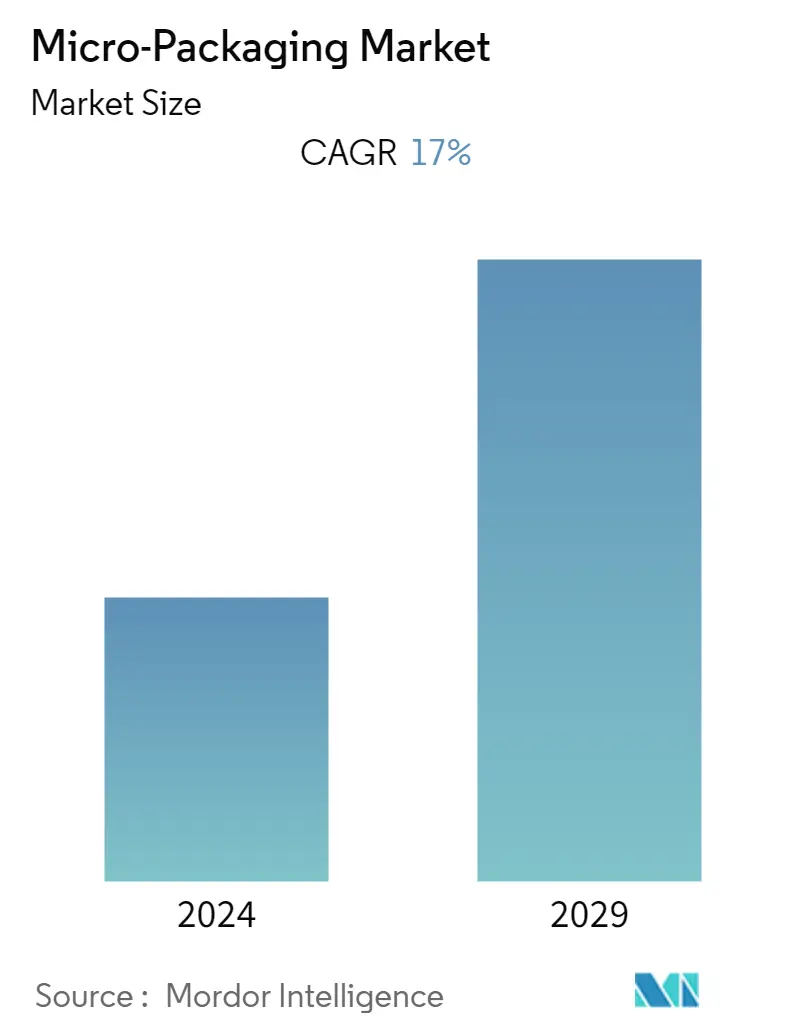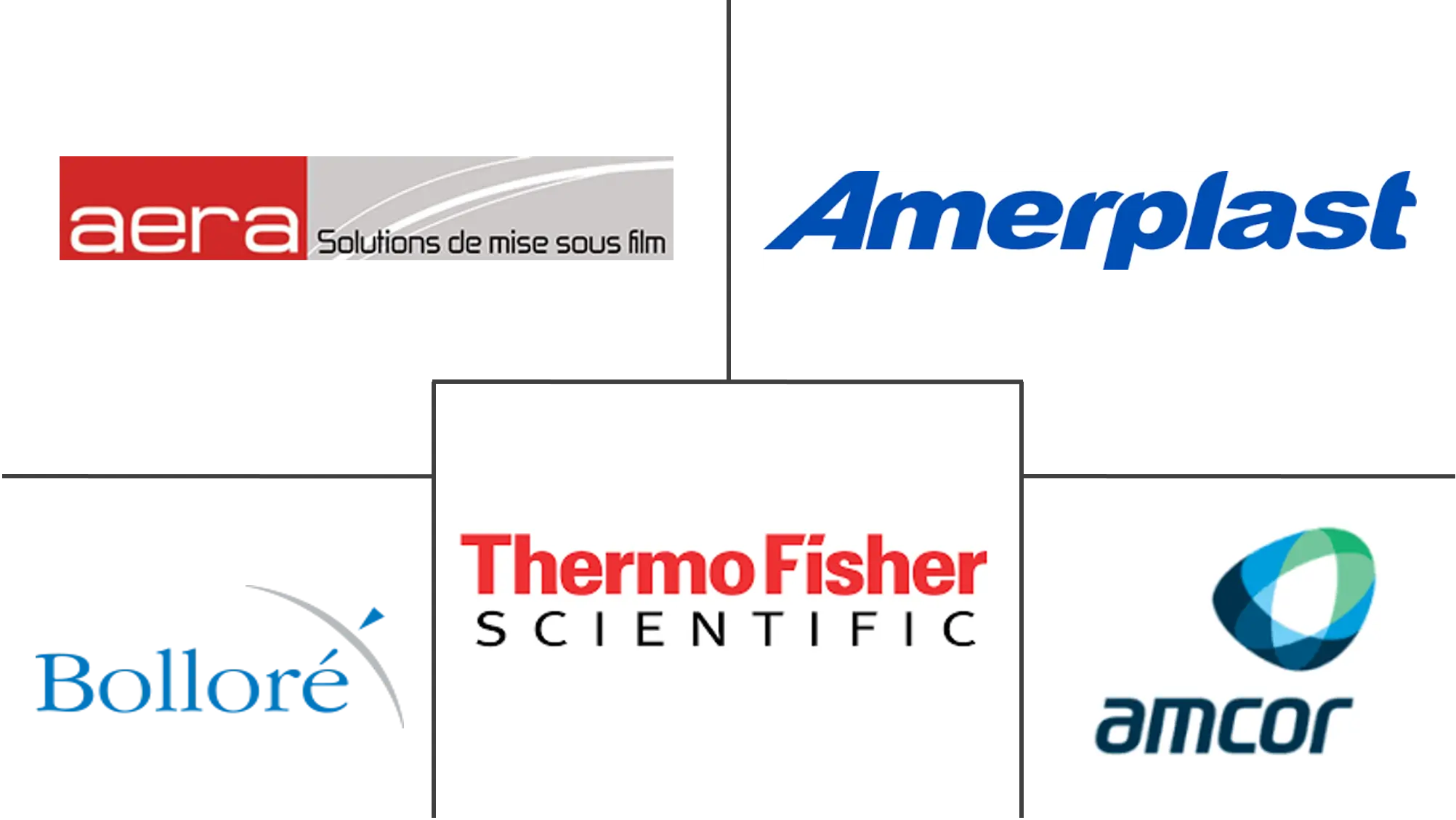Market Size of Micro-Packaging Industry

| Study Period | 2019 - 2029 |
| Base Year For Estimation | 2023 |
| CAGR | 17.00 % |
| Fastest Growing Market | Asia Pacific |
| Largest Market | North America |
| Market Concentration | Medium |
Major Players
*Disclaimer: Major Players sorted in no particular order |
Micro-Packaging Market Analysis
The micro packaging market is expected to grow at a CAGR of 17% over the forecast period (2021-2026). With the current study of plastic packaging, manufacturers are exploring alternatives such as plant-based fibers. An example is micro fibrillated cellulose (MFC) where plant fiber breaks down to micro levels and is reconstituted as packaging material. The process can create materials that are stronger and lighter than those made of glass or carbon fibers, and MFC can be added to other packaging materials to strengthen them. With the implementation in the future, this packaging technique can provide a new trend in the market.
- Micro-perforated food packaging is specifically used for perishable food products, aiming to extend shelf life and improve the moisture retention of the products. According to the Food and Agriculture Organization of the United Nations, in the United States, the production quantity for vegetables in 2018 increases to 807349 tonnes from 709033 tonnes in 2017. With the increasing consumption the growth for micro packaging increases. Also, scientists are focusing to enhance the functional properties of films for active food packaging. For instance, in Aug 2019, scientists from the Department of Process Engineering, Stellenbosch University, South Africa aims to form Acetylated hemicellulose films that are suitable for fatty foods packaging using acetylated nano-cellulose reinforcement and polycaprolactone coating.
- Also in Dec 2019, from the Department of Food and Nutrition, BioNanocomposite Research Center, Korea, scientists experimented with a synthesis of Fe3O4/SiO2/PAMAM dendrimer/AgNP hybrid nanoparticles for the preparation of carrageenan-based functional nanocomposite film which exhibits high UV-barrier property and clear antibacterial activity against foodborne pathogenic bacteria.
- The origin of new drug delivery systems and the development of new biochemical compounds drive the market. The burden of chronic diseases is rapidly increasing worldwide and according to WHO, it has been calculated that, in 2001, chronic diseases contributed approximately 60% of the 56.5 million total reported deaths in the world and approximately 46% of the global burden of disease.
- The proportion of the burden of NCDs (Non-communicable disease) is expected to increase to 57% by 2020. Almost half of the total chronic disease deaths are attributable to cardiovascular diseases; obesity and diabetes. These diseases cater a demand for medicine providing micro packaging owing to its ability to enhance stability and shelf life to the drug and the delivery system.
- Leaching of nanoparticles restraints the market to grow. There is an impact on the stability and chemical activity of nanomaterials, as the size and shape of the initial nanoparticles may change dramatically. For antimicrobial activity, a small amount of silver slowly migrate from the inside of the packaging material to the surface and release the silver ions to attack microorganisms. Consequently, AgNPs are probably ingested via food that contacts the packaging surface.
Micro-Packaging Industry Segmentation
Micro-packaging makes use of nanomaterials for prospective advantages such as enhanced antimicrobial effects, bio-availability, targeted deliverance of bioactive composites, thus increasing the demand for the micro packaging market in the end-user such as food, pharma, cosmetics, etc.
| By Application Type | |
| Vials | |
| Boxes & Pouches | |
| Trays | |
| Other Application Types |
| By End-User | |
| Food & Beverage | |
| Pharmaceutical | |
| Personal Care & Household | |
| Other End-Users |
| Geography | |
| North America | |
| Europe | |
| Asia-Pacific | |
| Latin America | |
| Middle-East and Africa |
Micro-Packaging Market Size Summary
The micro-packaging market is experiencing significant growth, driven by innovations in packaging materials and techniques. Manufacturers are increasingly exploring alternatives to traditional plastic packaging, such as micro fibrillated cellulose (MFC), which utilizes plant-based fibers to create stronger and lighter materials. This shift is part of a broader trend towards sustainable packaging solutions. Micro-perforated food packaging is gaining traction for its ability to extend the shelf life of perishable products by improving moisture retention. Advances in nanotechnology are also playing a crucial role, with scientists developing functional films and nanocomposite materials that enhance the protective properties of packaging. These innovations are particularly relevant in the food and pharmaceutical sectors, where the demand for packaging that maintains product integrity and extends shelf life is growing.
The market is further propelled by the rising consumption of packaged foods and the increasing need for effective drug delivery systems due to the global burden of chronic diseases. The United States, with its expanding population and robust retail sector, is a key market for micro-packaging solutions. The demand for advanced packaging materials that offer barrier properties and preserve freshness is on the rise, particularly in the meat and pharmaceutical industries. Despite the challenges posed by nanoparticle leaching, the market is witnessing a shift towards more competitive and fragmented landscapes, with key players like Amcor Plc, Bollore, and Amerplast Ltd. actively pursuing innovations and partnerships. Recent developments, such as the EU-financed NanoPack Project, highlight the potential of nanotechnology to enhance food safety and reduce waste, further driving the market's growth.
Micro-Packaging Market Size - Table of Contents
-
1. MARKET DYNAMICS
-
1.1 Market Overview
-
1.2 Market Drivers
-
1.2.1 Demand For Micro-Perforated Food Packaging For Perishable Food Products
-
1.2.2 Advent of New Drug Delivery Systems And the Development of New Biochemical Compounds
-
-
1.3 Market Restraints
-
1.3.1 Leaching of Nanoparticles
-
-
1.4 Industry Value Chain Analysis
-
1.5 Industry Attractiveness - Porter's Five Force Analysis
-
1.5.1 Threat of New Entrants
-
1.5.2 Bargaining Power of Buyers/Consumers
-
1.5.3 Bargaining Power of Suppliers
-
1.5.4 Threat of Substitute Products
-
1.5.5 Intensity of Competitive Rivalry
-
-
-
2. MARKET SEGMENTATION
-
2.1 By Application Type
-
2.1.1 Vials
-
2.1.2 Boxes & Pouches
-
2.1.3 Trays
-
2.1.4 Other Application Types
-
-
2.2 By End-User
-
2.2.1 Food & Beverage
-
2.2.2 Pharmaceutical
-
2.2.3 Personal Care & Household
-
2.2.4 Other End-Users
-
-
2.3 Geography
-
2.3.1 North America
-
2.3.2 Europe
-
2.3.3 Asia-Pacific
-
2.3.4 Latin America
-
2.3.5 Middle-East and Africa
-
-
Micro-Packaging Market Size FAQs
What is the current Micro-Packaging Market size?
The Micro-Packaging Market is projected to register a CAGR of 17% during the forecast period (2024-2029)
Who are the key players in Micro-Packaging Market?
Amcor Plc, Bollore Inc., Amerplast Ltd., Thermo Fisher Scientific and Aera SA are the major companies operating in the Micro-Packaging Market.

